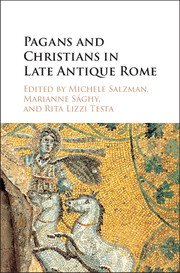 Pagans and Christians in Late Antique Rome
Pagans and Christians in Late Antique Rome Book contents
- Frontmatter
- Contents
- List of Illustrations
- Biographies of Authors
- Acknowledgments
- Introduction
- Part I SENATORIAL POLITICS AND RELIGIOUS CONFLICT
- Part II The Construction of New Religious Identities
- Part III Pagans and Christians: Coexistence and Competition
- Section A Pagans and Religious Practices in Christian Rome
- 8 Reinterpreting the Cult of Mithras
- 9 Napkin Art: Carmina contra paganos and the Difference Satire Made in Fourth-Century Rome
- 10 Poetry and Pagans in Late Antique Rome: The Case of the Senator “Converted from the Christian Religion to Servitude to the Idols”
- 11 Professiones Gentiliciae: The Collegia of Rome between Paganism and Christianity
- Section B Death and the Afterlife
- Section C Reading Religious Iconography as Evidence for Pagan–Christian Relations
- Concluding Remarks: Vrbs Roma between Pagans and Christians
- Index
- References
11 - Professiones Gentiliciae: The Collegia of Rome between Paganism and Christianity
from Section A - Pagans and Religious Practices in Christian Rome
Published online by Cambridge University Press: 05 November 2015
- Frontmatter
- Contents
- List of Illustrations
- Biographies of Authors
- Acknowledgments
- Introduction
- Part I SENATORIAL POLITICS AND RELIGIOUS CONFLICT
- Part II The Construction of New Religious Identities
- Part III Pagans and Christians: Coexistence and Competition
- Section A Pagans and Religious Practices in Christian Rome
- 8 Reinterpreting the Cult of Mithras
- 9 Napkin Art: Carmina contra paganos and the Difference Satire Made in Fourth-Century Rome
- 10 Poetry and Pagans in Late Antique Rome: The Case of the Senator “Converted from the Christian Religion to Servitude to the Idols”
- 11 Professiones Gentiliciae: The Collegia of Rome between Paganism and Christianity
- Section B Death and the Afterlife
- Section C Reading Religious Iconography as Evidence for Pagan–Christian Relations
- Concluding Remarks: Vrbs Roma between Pagans and Christians
- Index
- References
Summary
The Roman professional collegium has long been considered one of the principal elements of the economy and of daily life, especially as regards the lower social classes. The collegia were in fact an expression of the lower middle class of the Roman world, both in the West and in the East, of its desire to succeed, its potential, its economic activities, and its culture. If we fail to give it its due importance we lose a fundamental element for our understanding of Roman society and the organization of Rome's economy.
Even today, when approaching the theme of collegia we must first confront a methodological problem, that is, whether to privilege the professional or the religious aspect of these institutions. While a single, primary activity may have characterized the collegium, we must not forget that many other activities were carried out within each association as well. To attribute one exclusive activity to a collegium is a faulty approach, often dictated by a desire to simply catalog rather than understand the institution in all its complexity. The Roman collegia served a series of related functions that can be synthesized as follows: the professional element (it was a voluntary union of people who practiced the same profession, sharing the advantages and the disadvantages of their activity); religious aspects (the members honored and worshipped specific deities who protected their collegia and together practiced common cult rites, including the imperial cult); economic aspects (through the habere corpus, the legal entity recognized by the association, the management of the kitty and of other personal goods, as well as landed property and often very sizeable incomes, as well as the management of monopolies and of state concessions); territorial aspects (in the large centers, members often worked in the same area, whereas in small centers they represented an entire sector of the production of the town); social aspects (the socii presented themselves as a united group with respect to the state, to high-ranking personages, important administrative posts, or influential people, and in exchange their civic role and their position in the urban social hierarchy were recognized); political aspects (they developed profitable, reciprocal relationships with patrons and influential public personages); welfare (offering assistance to poorer members or to the families of members who had died);
- Type
- Chapter
- Information
- Pagans and Christians in Late Antique RomeConflict, Competition, and Coexistence in the Fourth Century, pp. 251 - 270Publisher: Cambridge University PressPrint publication year: 2015


